1. Introduction: Where is the next Alpha in the Bitcoin ecosystem after the Memes?
The domino effect of the Memes has demonstrated the potential of the Bitcoin blockchain. If a few months ago there was still debate about the legitimacy of building the Bitcoin ecosystem, it seems that this issue has now been diluted by the high market enthusiasm—people have higher expectations for the Bitcoin ecosystem. The attention to the Bitcoin ecosystem started with the Memes, but it will not stop at Memes. After the Memes, the market will begin to explore the infrastructure and functional products of the entire ecosystem.
First, the explosion of the Memes has brought long-standing problems in the Bitcoin ecosystem back into the public eye. Firstly, the infrastructure construction in the Bitcoin ecosystem is severely lacking, greatly limiting the trading of BRC-20 tokens. Binance Research also mentioned in a research report on BRC-20 that the deployment of decentralized indexes and fully functional DEX will lead BRC-20 to the next level. Secondly, Bitcoin's extremely low TPS and block capacity have led to extreme congestion and high transaction fees, which also restrict the issuance and trading of Memes, bringing the discussion of Bitcoin scaling solutions back to the market's focus.
Secondly, with the halving of BTC approaching, the sustainability of BTC miner revenue has once again sparked discussion. Miner revenue consists of transaction fees and mining rewards. Due to the limited ecological applications on the Bitcoin network, the vast majority of current revenue comes from mining rewards. With the diminishing potential for BTC market value growth, post-halving, mining rewards may not be able to sustain the security of the BTC network in the long term. The expansion of BTC ecological applications may introduce sustained transaction fees, providing sustainable sources of income for Bitcoin miners.
At the same time, the Bitcoin blockchain has the strongest consensus, legitimacy, security, and decentralization among all blockchains. Establishing smart contracts on the Bitcoin network would be an extremely encouraging narrative. However, Bitcoin itself is not Turing complete and cannot support smart contracts. In order to expand the potential of the Bitcoin blockchain, we must currently focus on Bitcoin L2. Unlike Ethereum, the experience of Bitcoin smart contracts is not a choice between L1 and L2 for users. L2 is currently the necessary technology that endows Bitcoin smart contracts with capabilities, and the main L2 solutions include Lightning Network, Stacks, Rootstock, and Liquid.
This is where Alex Lab comes into view. Built on top of Stacks, Stacks is the most prosperous and highest valued ecosystem in the Bitcoin L2, and Alex is the leading DeFi protocol on Stacks. Alex Lab is dedicated to building the DeFi system for Bitcoin and has launched and is developing a range of features including BRC-20 token indexing, Bitcoin bridge, AMM, order book, staking, Launchpad, and other functions, laying the foundation for a complete DeFi ecosystem, providing comprehensive infrastructure support for the development of Memes and BRC-20 tokens.
2. Deconstructing Alex Lab: The Infrastructure Leader of Bitcoin DeFi
Alex Lab provides a rich array of products for Bitcoin ecosystem finance, including core products such as AMM and Orderbook DEX for trading, Launchpad for discovering and participating in IDO within the Stacks ecosystem, staking and liquidity mining, cross-chain bridges connecting Bitcoin L1 and L2, and Stacks with other chains, and a Bitcoin oracle for decentralized indexing of BRC-20.
AMM and Orderbook
Alex Lab has simultaneously launched AMM Swap and B20 Market (Orderbook). We will not delve into the specific mathematical curves of AMM here. Currently, there are 5 pools with liquidity exceeding $1M on AMM, including: STX-aBTC ($2.71M), STX-ALEX ($23.76M), STX-xBTC ($5.84M), STX-sUSDT ($1.49M), ALEX-atALEX ($6.82M).
The B20 Market operates in the form of an order book, using a hybrid on-chain/off-chain design. Commitments to buy or sell certain assets are transmitted through encrypted signatures, and matching is done off-chain by a matching engine before settlement on-chain, allowing users to create and cancel orders without paying gas fees. Multiple BRC20 token-sUSDT trading pairs are currently listed on the B20 Market. The 24-hour trading volume of the B20 Market is 675k, with a cumulative trading volume of 55.8M.

Launchpad Platform
Alex Launchpad adopts a hybrid on-chain/off-chain model to provide an IDO platform for BRC-20 tokens. All transactions related to user funds are on-chain, while the high-cost lottery part is completed off-chain and submitted to on-chain contracts for verification. The community can decide on IDO projects through governance voting. Currently, 5 IDO projects have been completed:
ALEX (2022.1.19)
BANANA (2022.6.21)
ORMM (2023.7.28, BRC20 token)
Bluewheel Mining (2023.8.25)
CHAX (2023.11.13, BRC20 token)
There are not many projects in the Stacks ecosystem, and even fewer token issuance projects. ALEX's Launchpad has not yet demonstrated much ecological value.
Recently, Alex has upgraded to a multi-chain Launchpad, where projects can be issued on BRC20, Stacks, and ERC20. The first candidate project for the ALEX multi-chain Launchpad is OrdzGames, a game project on the Bitcoin network, with the community set to complete voting on December 23.
Staking and Liquidity Mining
The staking rewards of Alex Lab's native token are greatly influenced by whether automatic staking is chosen (see the token economics section). The current total staking amount is 143.6M, with a token circulation of 642.1M, resulting in a ratio of 22.4%.
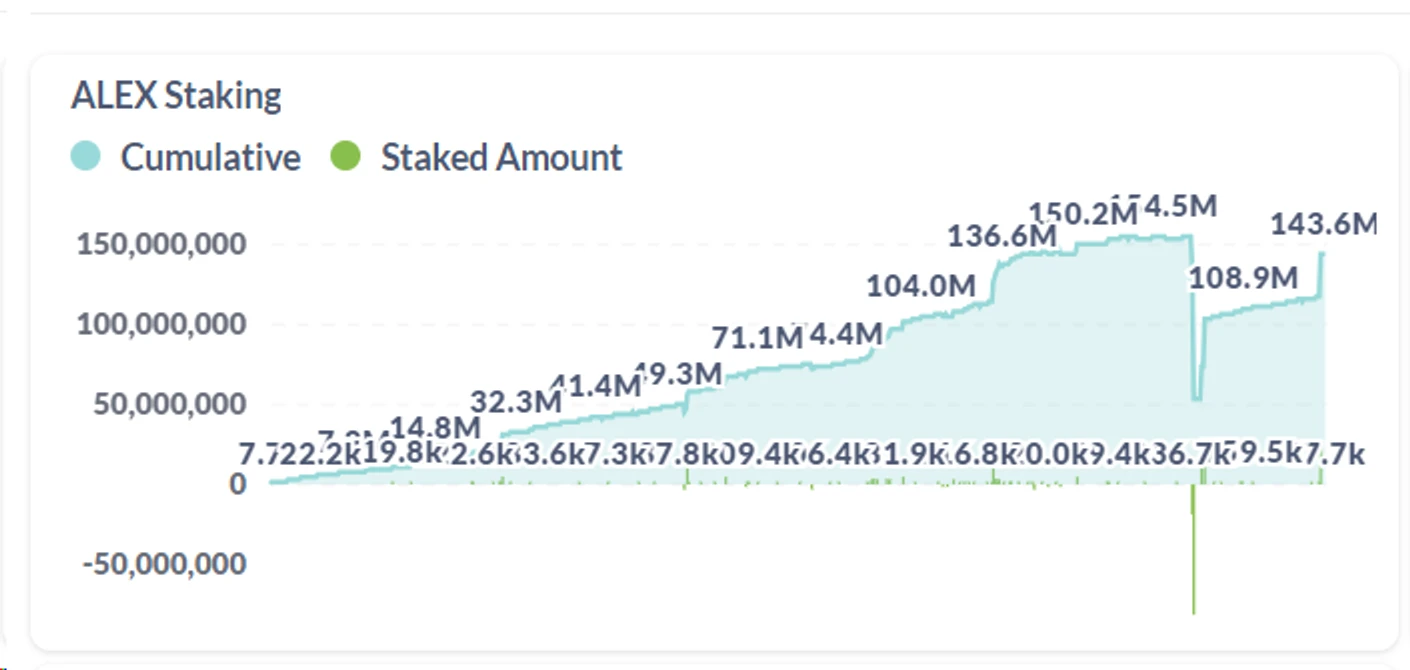
Users can also choose to stake LP tokens for liquidity mining. The main LP pairs are currently STX-ALEX and STX-xBTC, with APRs of 34.94% and 63.6% respectively, distributed in ALEX tokens, but the staking amounts are not performing well.
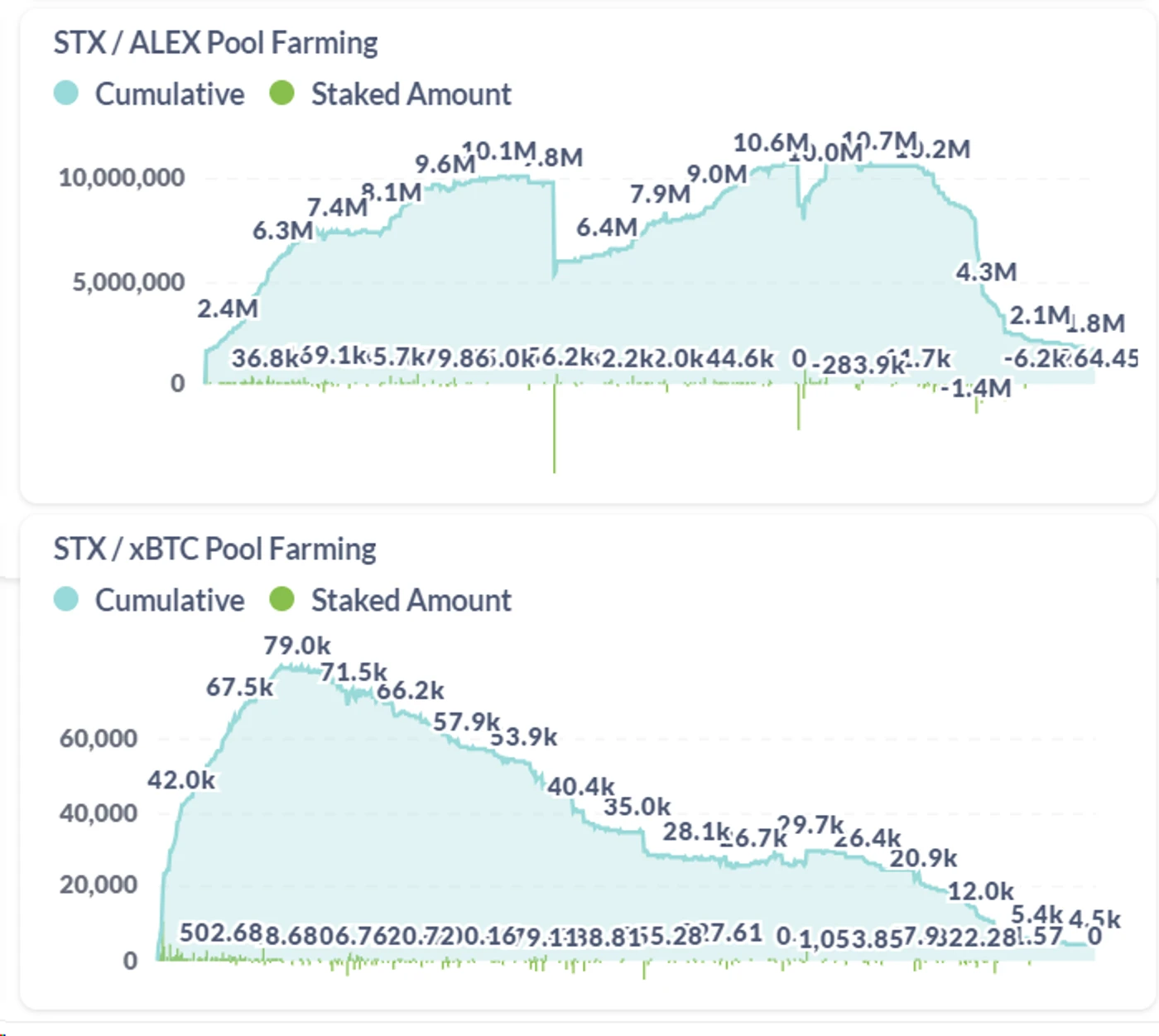
Cross-Chain Bridge
Alex Lab has currently developed cross-chain bridges between Stacks and the Bitcoin network, Ethereum, and BSC Mainnet. It supports cross-chain bridging of BTC and BRC-20 tokens with the Bitcoin layer 1, and cross-chain support for USDT, LUNR, and BTCB (BSC)/WBTC (Ethereum) with Ethereum and BSC. The total accumulated cross-chain value is currently $11,568,749, with a total cross-chain fee of $76,067, and the current TVL is $2,324,830.
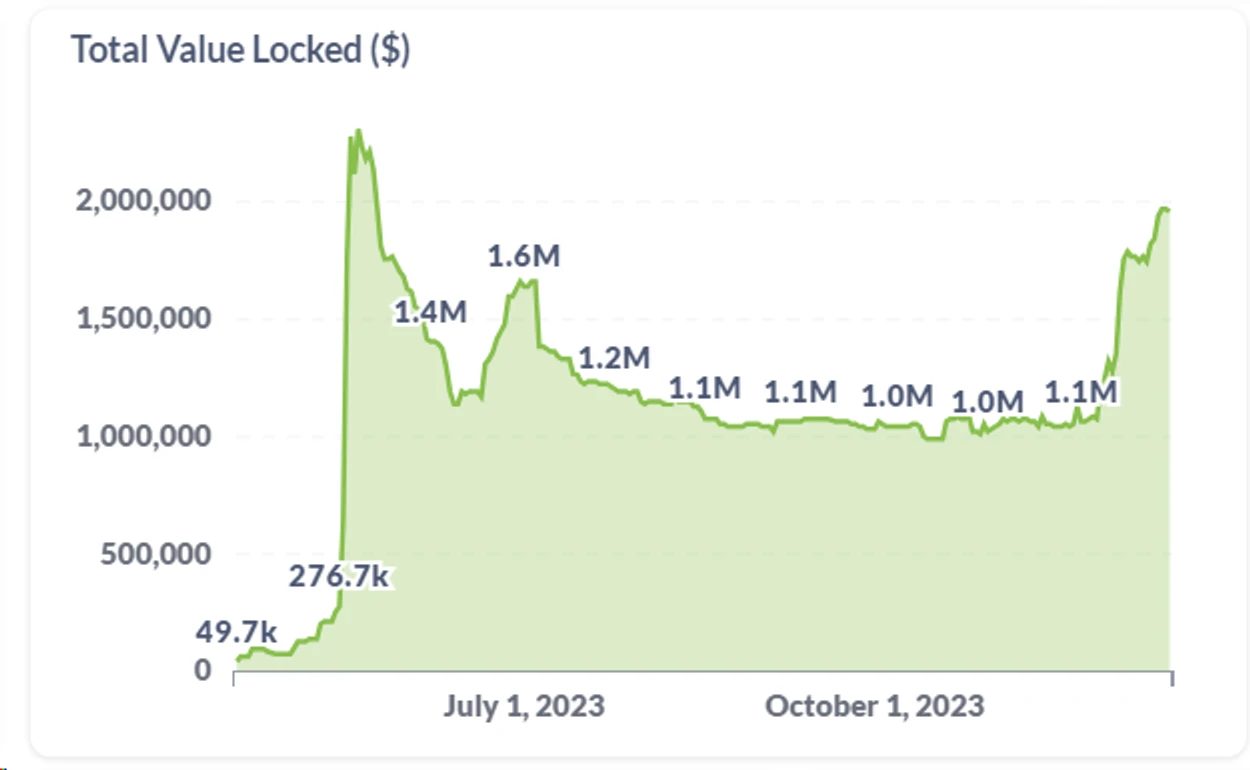
Bitcoin Oracle
The Bitcoin Oracle mentioned here is different from the oracles commonly mentioned on Ethereum. It currently refers to the decentralized, tamper-proof, and censorship-resistant indexing of BRC-20 on Bitcoin. Although BRC20 exists entirely on-chain, Bitcoin L1 natively does not support BRC-20 tokens and cannot read inscription data.
Users who have interacted with Memes and BRC-20 tokens know the importance of indexing, which indicates which Memes have been minted and records transfers and other operations, forming the foundation of the BRC-20 market. The current BRC-20 market relies on centralized off-chain indexers, where errors from a single indexer may arise due to performance issues or even censorship and malicious behavior, posing risks to user assets.
Therefore, Alex Lab is collaborating with Domo, the founder of the BRC-20 token standard, and existing major off-chain indexers (such as BestinSlot, OKX, Hiro system, Unisat, etc.) to build on-chain indexing for BRC-20. Specifically, the Bitcoin Oracle aggregates data from off-chain indexers, then verifies each transaction through Stacks, choosing to accept or reject it, to provide a single, reliable source of truth. Dapps and wallets can efficiently access and query the data and events of the Bitcoin Oracle. Recently, the official Twitter of Alex announced that the Bitcoin Oracle will support STX20.
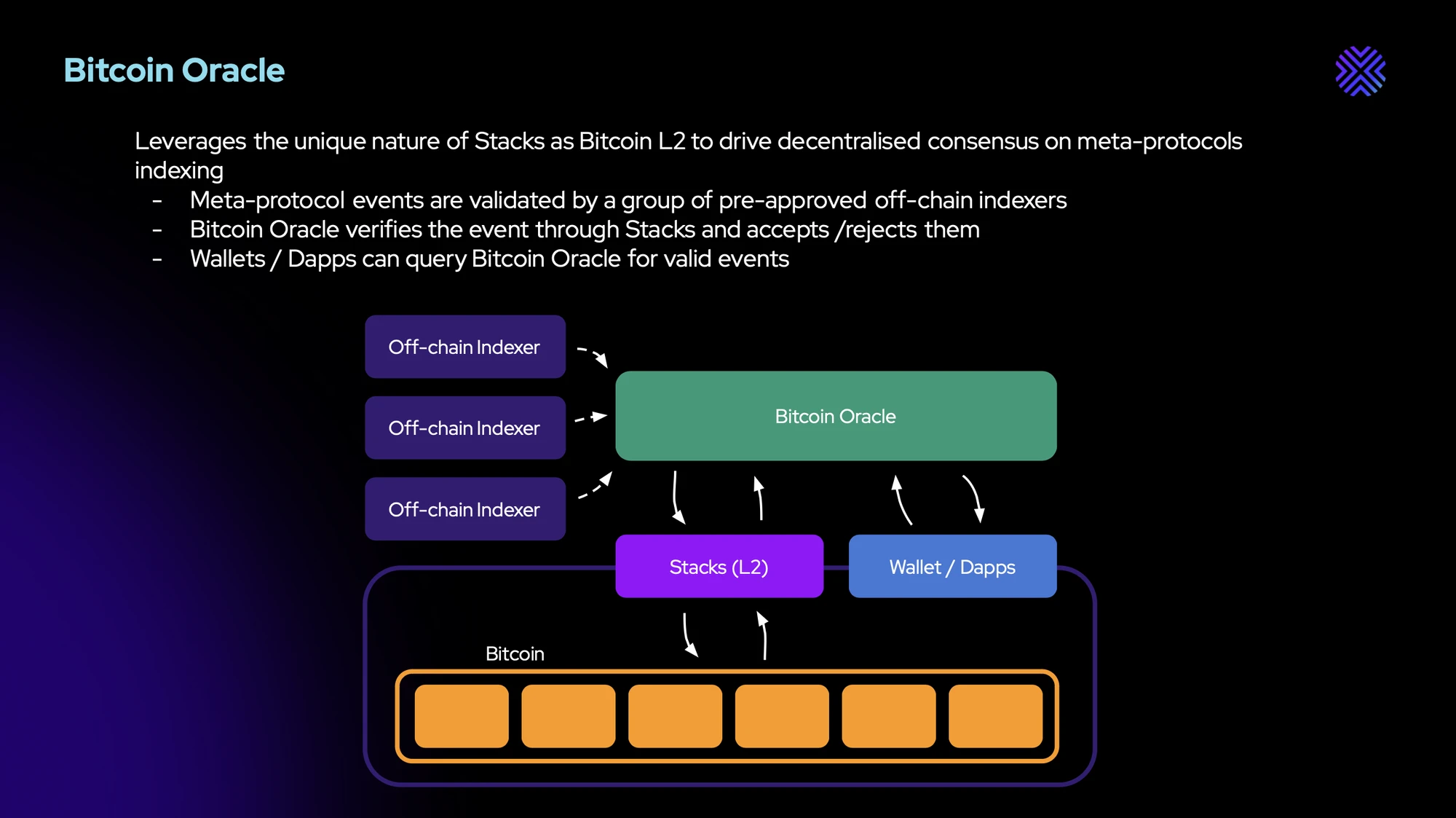
3. Competitive Landscape: The Absolute Leader of Bitcoin DeFi
Alex Lab currently has no competitors on Stacks, so the analysis of the competitive landscape needs to look at the entire BTC Layer 2 to find Alex's opponents, starting with finding Stacks' opponents.
Currently, the main Bitcoin Layer 2 networks are Lightning Network, Rootstock, Stacks, and Liquid Network. According to a report by Crypto.com, they mainly differ in performance as follows:
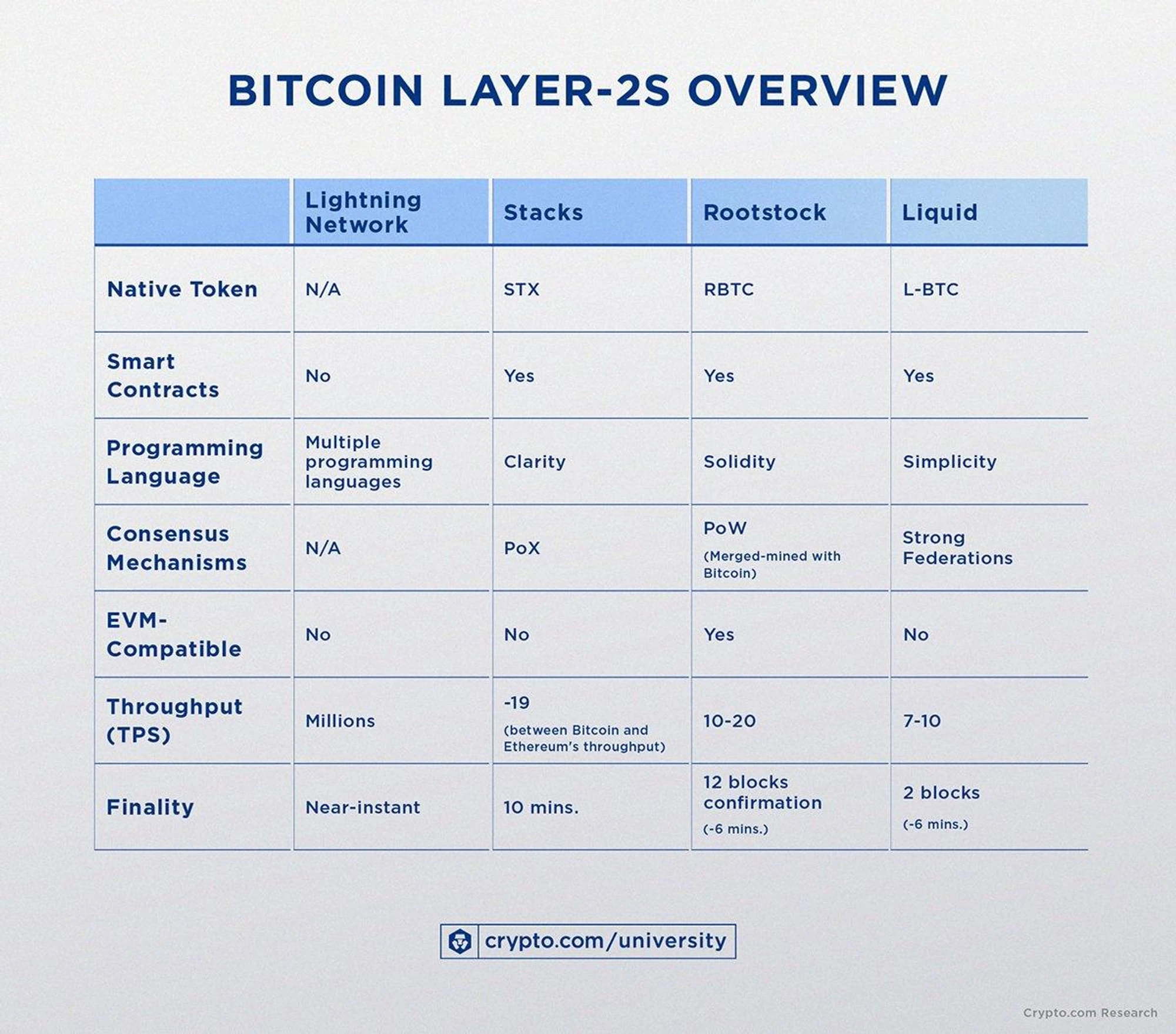
Stacks is the most prosperous ecosystem among Bitcoin scaling solutions. Lightning Network, as a payment channel, cannot support the construction of smart contracts and is therefore not a direct competitor to Stacks. The consensus mechanism of the Liquid Network makes it highly centralized, making it difficult to inherit the legitimacy of the BTC network. Currently, the most direct competitor to Stacks is Rootstock. Rootstock is a sidechain on Bitcoin that is compatible with EVM, and Bitcoin miners can engage in merged mining and earn transaction fees from Rootstock. Rootstock's advantage is its compatibility with EVM, early start, and currently higher TVL (as of 2023/12/17). However, in comparison, Stacks has a more decentralized advantage in technology and faster data growth and ecosystem development speed.
Technologically, after the Nakamoto upgrade, Stacks will introduce sBTC anchored in a decentralized manner, while RSK's BTC cross-chain relies on trust in pre-set federations, posing centralization issues. After the Nakamoto upgrade, Stacks will introduce subnets to support more languages and execution environments.
In terms of data, Stacks' TVL has grown rapidly after 2023, reaching the previous high, while Rootstack's data growth has been relatively slow, currently only reaching 50% of the previous high.
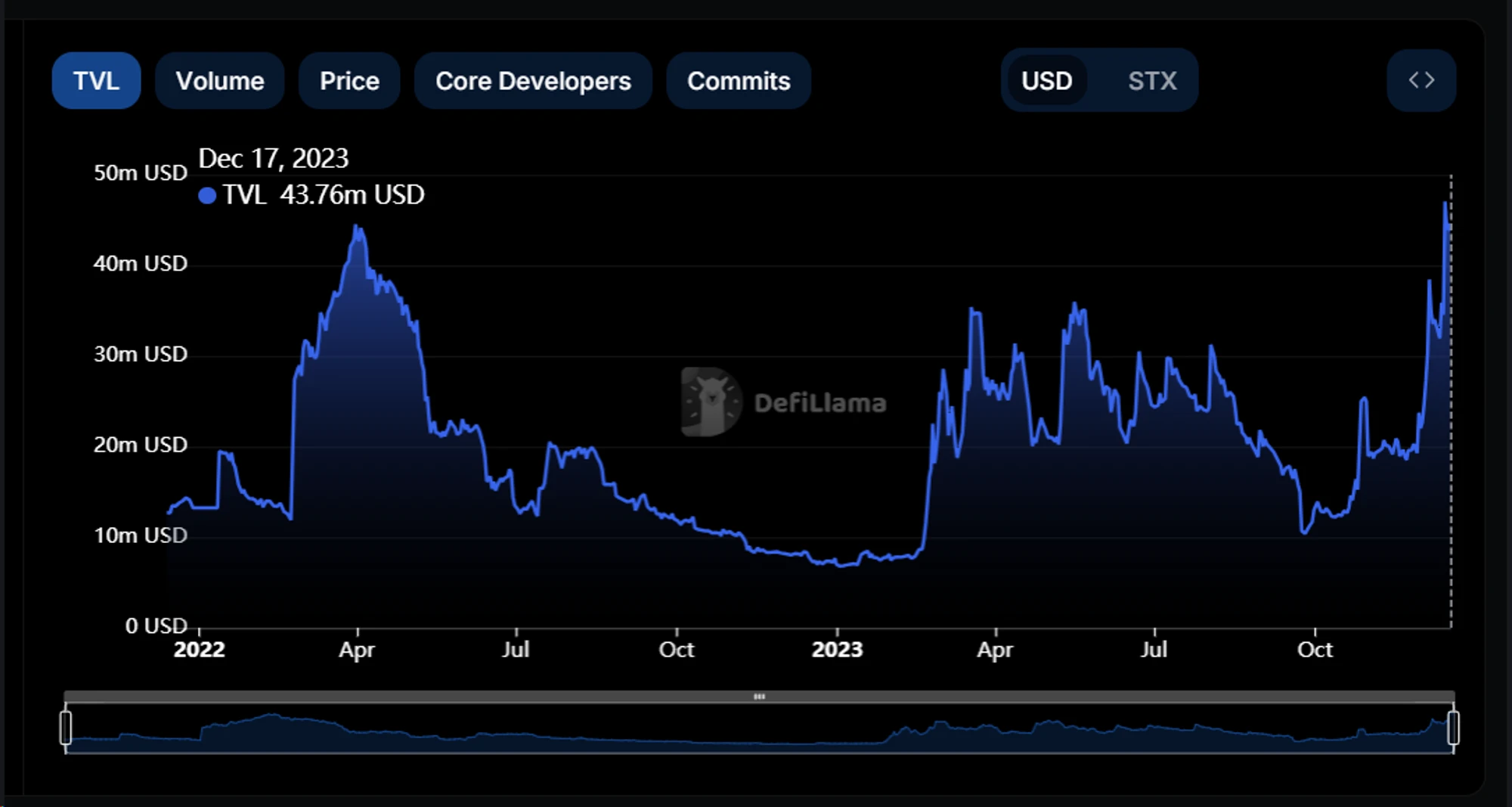
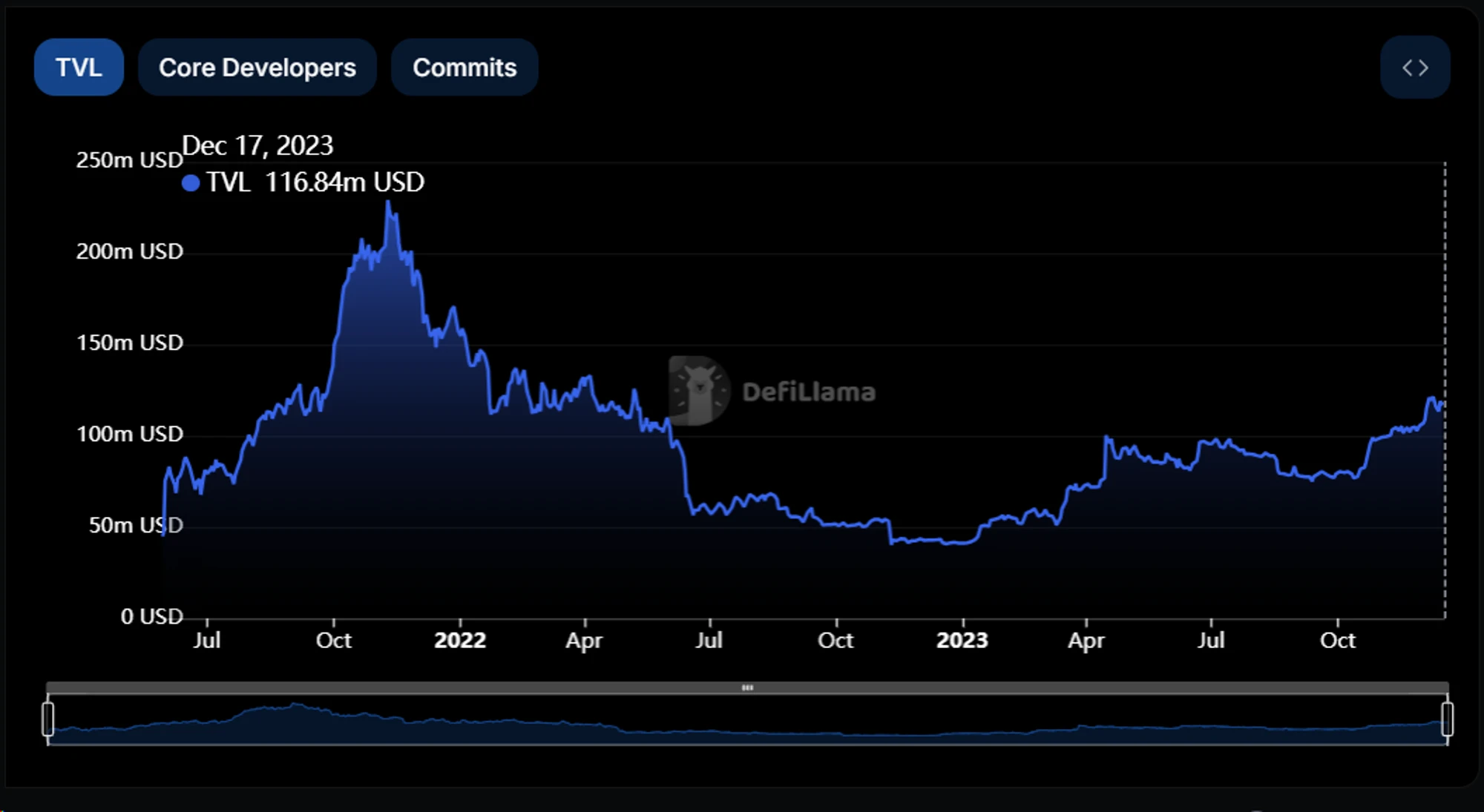
- In terms of ecosystem development, according to veDAO's statistics on the Bitcoin ecosystem (https://docs.google.com/spreadsheets/d/1DcGIbjZX3gDDwF2wqTHijOftss4j1UxeciJuT2Y6Ebk/edit#gid=1323064746), there are fewer projects on RootStack, with the main four Dapps being Sovryn, Money on Chain, Liquality, and Tropykus, with Liquality being a wallet infrastructure and the other three being basic DeFi applications. Stacks has a flourishing ecosystem, with over 60 Dapps released according to veDAO's statistics, covering DeFi, wallets, NFTs, games, social, and more.
The largest DEX on Rootstock is Sovryn, which can be seen as a competitor to Alex Lab. Sovryn provides a comprehensive set of DeFi services, including stablecoins, AMM, lending pools, and margin trading. However, there are differences in business focus between the two, with Sovryn mainly focusing on stablecoins in the Bitcoin ecosystem, while Alex Lab's recent development focus is on providing infrastructure for BRC-20 tokens. In terms of data performance, Sovryn's TVL growth is weak, while Alex Lab has risen along with the BRC-20 boom.
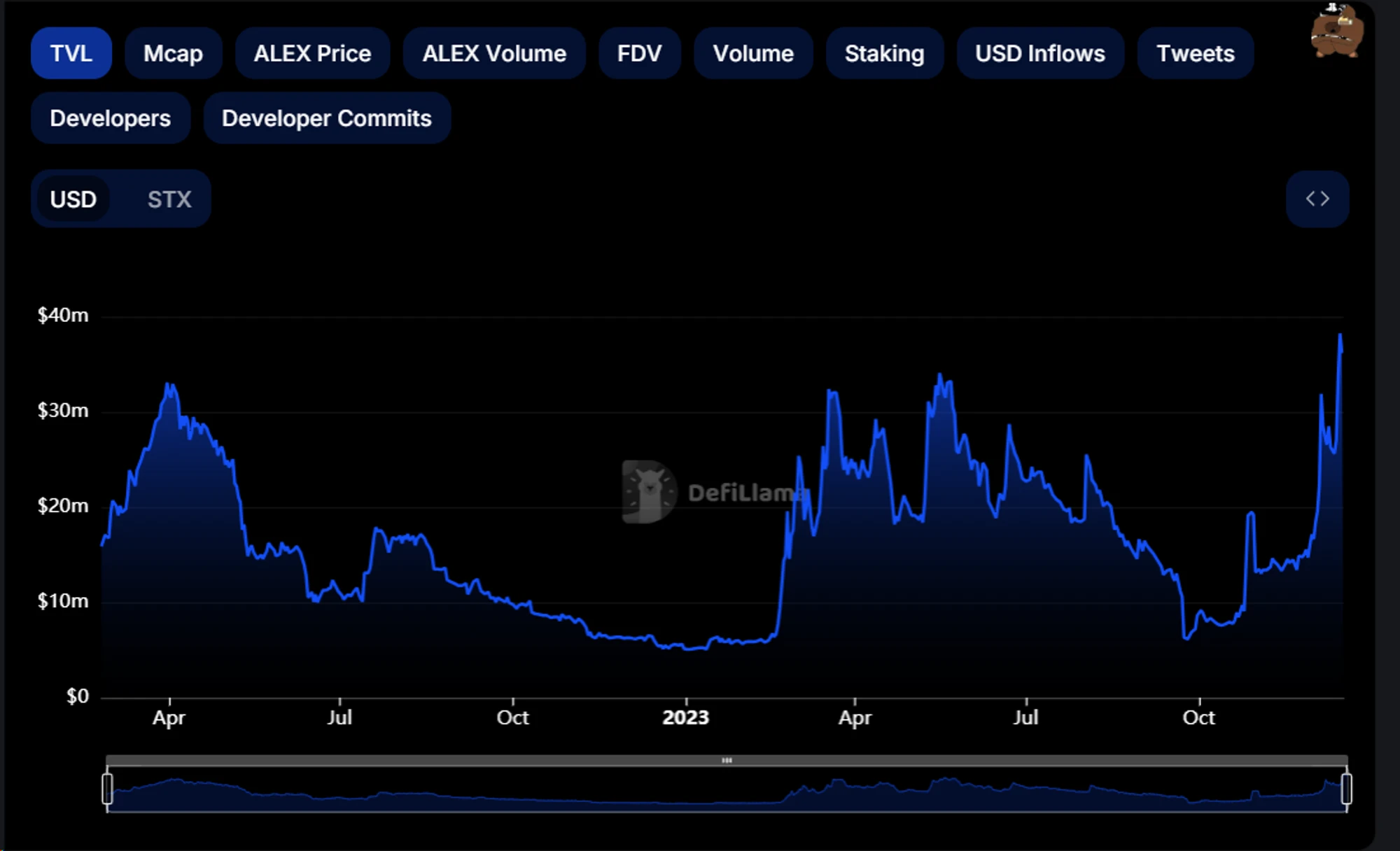
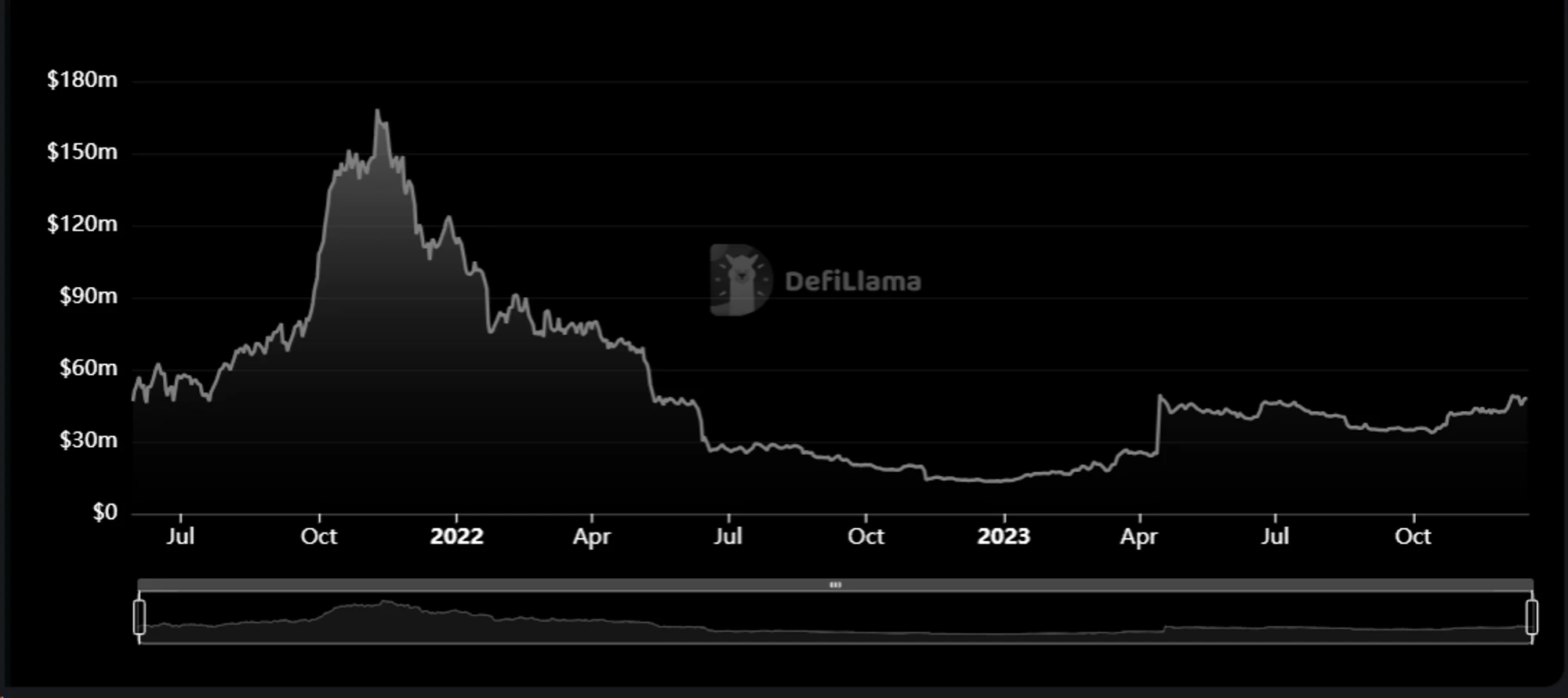
4. Nakamoto Upgrade: New Opportunities for Bitcoin DeFi
In early 2021, Stacks is set to undergo a major upgrade in the first quarter of 2024: the Nakamoto upgrade. This upgrade will bring three main functional upgrades: (1) Decentralized two-way anchoring of Bitcoin, i.e., the issuance of sBTC; (2) Transactions secured by Bitcoin finality; (3) Fast transactions between Bitcoin blocks. The issuance of sBTC will unlock Bitcoin as a fully programmable productive asset, allowing smart contracts to be written into the Bitcoin blockchain without the need for trust, unlocking the application of Bitcoin assets in DeFi.
The main mechanism of sBTC can be summarized as follows: users send BTC to a hooked wallet/script on the Bitcoin network, and an equal amount of sBTC is minted and sent to the user's chosen Stacks address, maintaining a 1:1 peg; when users wish to send the assets back, the sBTC will be burned, and the BTC will be transferred to the user's address on the Bitcoin network. Since the Bitcoin network does not have Turing completeness, the process of locking BTC on Bitcoin requires the use of a custodial wallet/script rather than a smart contract, managed by a group of Signers. After a Peg-out (burning anchored assets on the anchoring chain), the release of BTC must be manually completed by the Signers. Therefore, the Peg-in process is guaranteed by the smart contract of the target chain for the release and transfer of assets, while Peg-out requires the managers to complete the release of assets. The key point of BTC anchoring lies in the Peg-out process.
A group of Stakers lock STX to maintain the peg and perform threshold signature tasks (the threshold is determined by the proportion of STX locked by this group of participants). They will receive BTC as a reward for correctly completing the peg operation. The permission to participate in maintaining the peg transactions is open to everyone, and anyone can become a signer for peg transactions. As a security measure, sBTC requires two important thresholds: (1) the signature threshold is set at 70%, meaning that more than 71% of Stackers must act maliciously for a security issue to occur; (2) Liveness Ratio: the maximum ratio of sBTC supply to the locked value of STX, currently set at 60% by default. These two values ensure that the locked value of STX signing transactions is greater than the value of the processed BTC, avoiding malicious behavior through economic incentive design. In addition, signer selection, Peg-out requests, etc., occur on L1, following Bitcoin's censorship resistance. Stacks can directly read transactions on Bitcoin, so it does not need to rely on external oracles. All of these make sBTC closer to the security of BTC.
How will the Nakamoto upgrade and sBTC empower the development of Alex Lab? Firstly, the Nakamoto upgrade will make Stacks transactions more secure and reliable, greatly improving network performance. The introduction of subnets makes it possible to support other programming languages and environments, such as the EVM subnet, making project migration more convenient and providing conditions for the explosion of ecosystem projects, strengthening Stacks' leading position in the Bitcoin ecosystem. As the largest DEX in the Stacks ecosystem, Alex will directly benefit from this enhancement. Secondly, BTC is the most decentralized and secure asset. Unlocking the huge market value potential of BTC and bringing BTC into DeFi will greatly enhance the security and legitimacy of DeFi. It should be noted that the currently available BTC-anchored assets (such as wBTC on Ethereum) are entrusted to centralized entities or a trusted group of managers, fundamentally raising trust issues and contradicting the spirit of Bitcoin. In contrast, sBTC is operated by a group of permissionless, decentralized, and dynamic participants, maintaining correct pegging through economic incentive design. Although it still introduces risks and complexity, it has largely achieved the security of BTC. Leveraging the immense value of BTC and maximizing the security of BTC will bring a new narrative to DeFi, and as the leading DeFi application on Stacks, Alex will be the core direct beneficiary of this upgrade. In summary, the Nakamoto upgrade will greatly enhance the performance of Stacks, attracting market attention in terms of narrative and fundamentals. Given that the incremental market value space of Stacks is relatively small, Alex will be the best target for positioning in this upgrade. How is the current progress of the Nakamoto upgrade and sBTC? What will the future timeline look like?
In October 2023, Stacks released the developer version of sBTC, allowing developers to build and test with early versions of sBTC. On December 15, Stacks co-founder announced that the Stacks Nakamoto testnet (codenamed Neon) has completed code writing, and the launch of the testnet by the end of the year has been confirmed.
According to the latest timeline released by Stacks Foundation, the Nakamoto upgrade will be released before the Bitcoin halving, and sBTC will be launched subsequently after the mainnet release is confirmed. In the initial roadmap, Nakamoto and sBTC were planned to be released together, but the plan is currently to achieve them through separate upgrades to reduce overall complexity and increase the predictability and security of the upgrade. The team plans to launch the public testnet Argon in the first quarter of 2024, release the Nakamoto upgrade before the Bitcoin halving, and sBTC is expected to go live on Stacks around 2 months after the upgrade.
However, it should be noted that the Nakamoto upgrade has experienced two delays, from initially planned for completion in the summer of this year, to delayed to the end of 2023, and then to Q1 of next year. If the Nakamoto upgrade is not completed before the Bitcoin halving, expectations will be dashed again, and the upgrade narrative cannot be overlaid with the halving narrative, which may have a certain impact on the overall coin price of the Stacks ecosystem. It will be necessary to closely monitor the progress of the Stacks upgrade, with the upcoming milestone being the launch of the Neon testnet at the end of December.
5. Token Economics and Liquidity Distribution
In terms of token distribution, Alex Lab conducted a token issuance in March 2022, with a total supply of 1,000,000,000 tokens, expected to be fully unlocked within five years (by February 2027). The distribution is as follows:

20% allocated to the foundation, distributed to the community reserve pool to support the ALEX ecosystem, early adopters, and future development
50% reserved for the community, to earn ALEX through staking or providing liquidity tokens
30% allocated to employees, advisors, early investors, and the founding team
In terms of token use cases, $ALEX can be used for staking and governance. The staking rewards greatly depend on whether automatic staking is chosen. Currently, a total of 140 million tokens have been staked, with an APY of 7.25%. $ALEX and $atALEX (automatically staked ALEX) can participate in community governance voting, including changes to token economics, selection of IDO projects, and more.
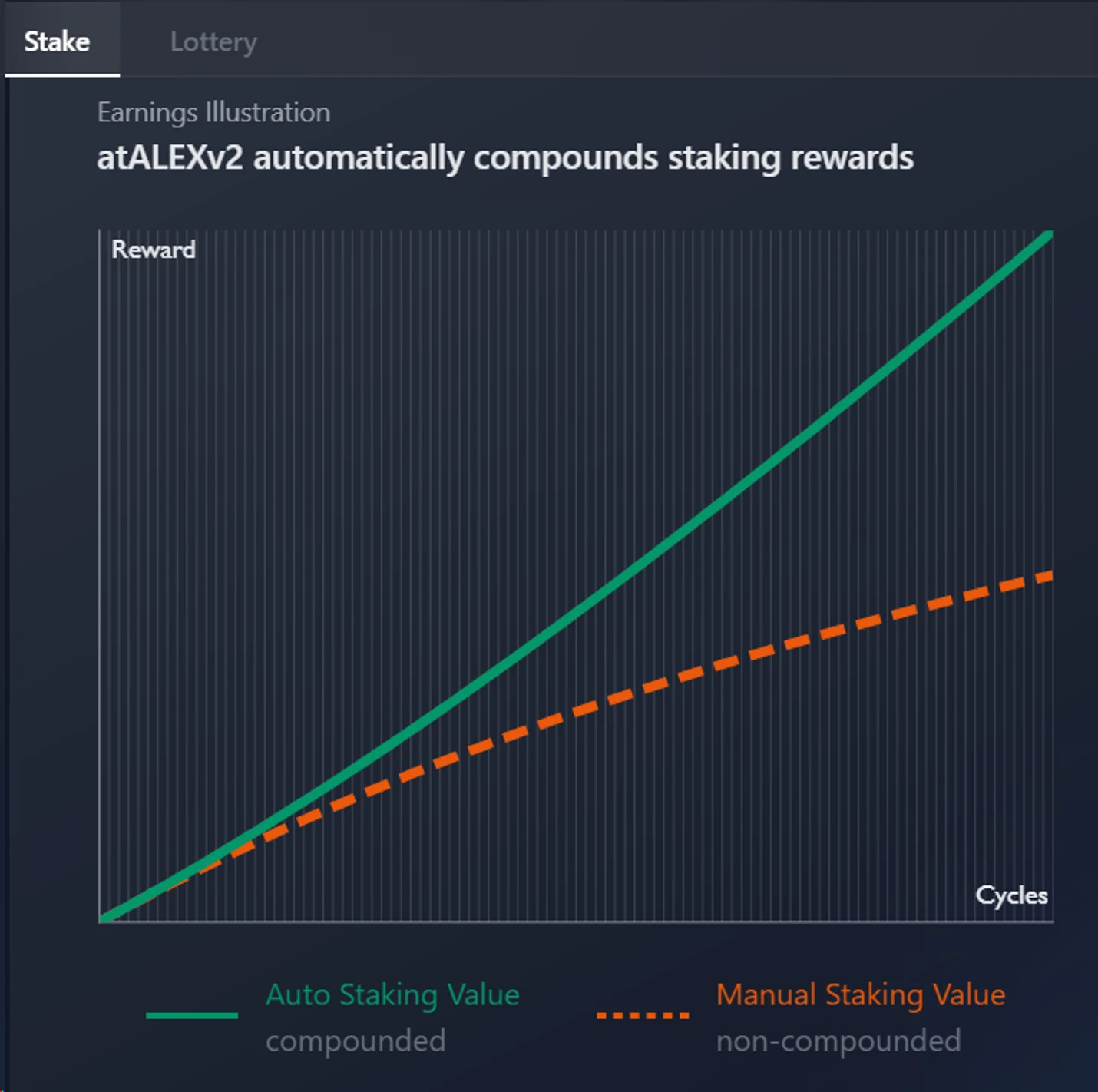
In terms of token performance, the current market value of $ALEX is $287,738,006, with a FDV of $439,423,517, and an MC/FDV ratio of 65.48%. The circulating token ratio is relatively high. In terms of market value, ALEX is currently ranked 181st. For comparison, the current market value of Stacks is $2,079,014,811, with a FDV of $2,645,163,967, making the market value nearly 8 times that of ALEX. Although Stacks, as a layer 2 public chain, has a higher valuation potential than ALEX, ALEX is the most comprehensive leading protocol built on Stacks. In the medium term, ALEX can be considered as a leveraged target for investing in Stacks. (All data as of 12/21/2023)
In terms of liquidity, ALEX's main trading volume is currently concentrated on Bithumb, Gate, and Alex AMM, with relatively poor liquidity and has not yet landed on major exchanges. Recently, major BRC-20 tokens have been listed on Binance and OKX exchanges, indicating the current mainstream CEX's attention to the Bitcoin ecosystem. The release of listing information has led to significant growth in token value. As the leader in Bitcoin DeFi, ALEX has potential for future listings, which will bring speculation and improved liquidity, further enhancing the price growth potential of $ALEX.
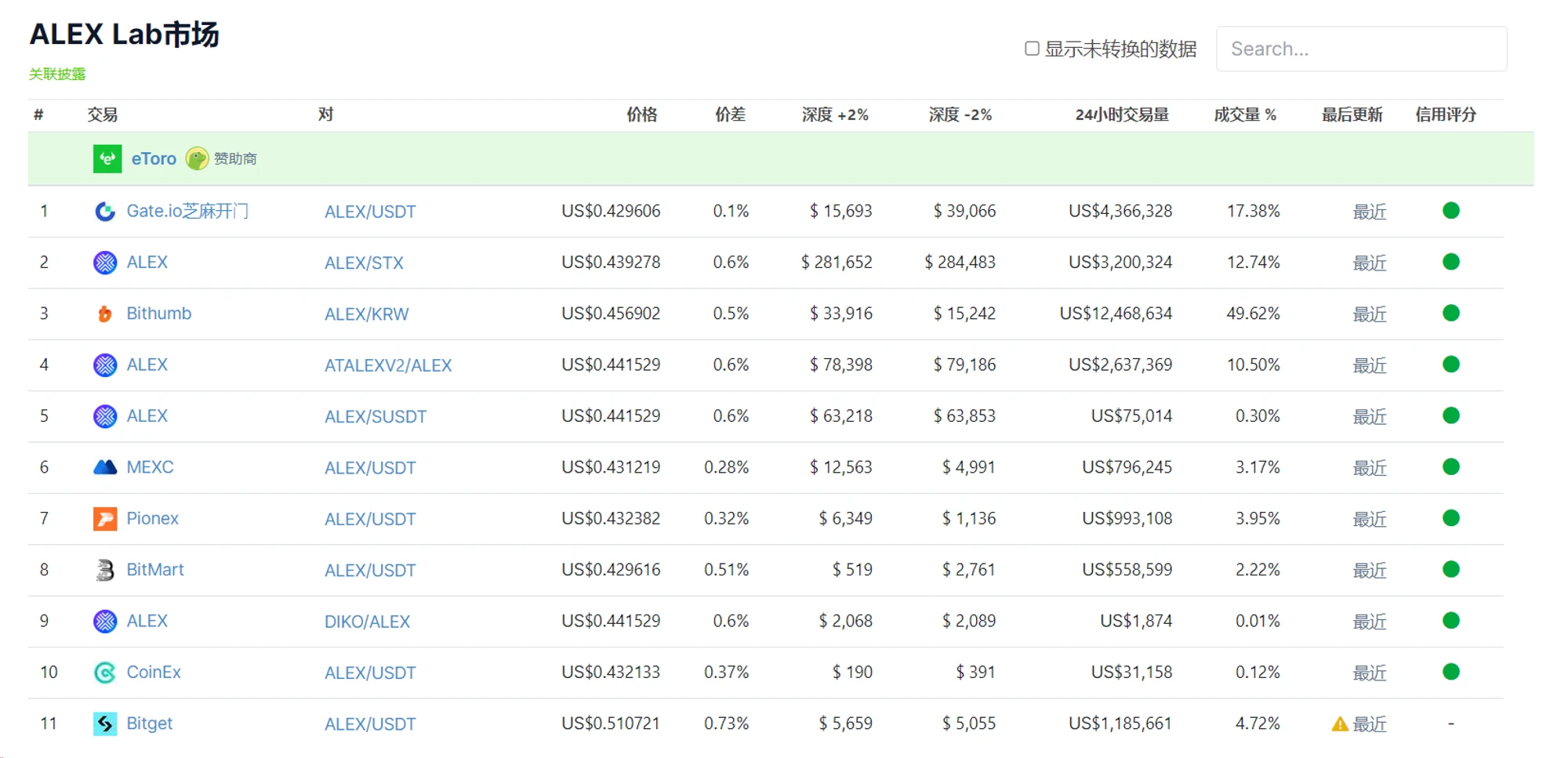
6. Conclusion
In summary, our basic views on Alex Lab can be summarized as follows:
Firstly, under the high popularity of inscriptions and BRC-20 tokens, the Bitcoin ecosystem has the conditions to become the mainstream narrative of the bull market, and the Bitcoin halving in April will increase the speculative value of this track. Considering the security and legitimacy of the Bitcoin network, as well as the issue of sustainable incentives for miners, building the Bitcoin ecosystem has significant practical significance. DeFi is the cornerstone of the ecosystem, and as the leader of Bitcoin DeFi, Alex Lab will provide the foundation for the subsequent expansion of the Bitcoin ecosystem.
Secondly, Alex Lab closely follows the development of BRC-20 tokens, rapidly developing on-chain indexing, Orderbook trading markets, and Launchpad for BRC-20, seizing the opportunity in the lack of infrastructure for BRC-20 tokens and becoming one of the few projects deeply involved in the BRC-20 token narrative in the Bitcoin expansion layer, with practical product implementation. This will unlock more financial use cases for BRC-20 tokens.
Thirdly, in terms of competitive landscape, Alex Lab is the absolute leader project on Stacks. After completing the Nakamoto upgrade, Stacks will further consolidate its leading position as a Bitcoin scaling solution. Compared to the leading Sovryn on Rootstock, Alex Lab has significant advantages in data performance, development progress, and connection to the BRC-20 narrative. Therefore, in the field of Bitcoin DeFi, Alex Lab has strong competitiveness and an absolute leading position.
Fourthly, the Nakamoto upgrade is an important event in the Bitcoin scaling field, and the release of sBTC will unlock the potential and value of Bitcoin DeFi, improving security and legitimacy. Alex Lab will be the core target for positioning in this event.
Fifthly, considering the market value and FDV of Alex Lab and Stacks, we believe that in the medium term, ALEX can be considered as one of the leveraged targets for positioning in the Stacks ecosystem. Major exchanges are vying for the Bitcoin ecosystem, and the future listing of ALEX tokens will bring more abundant liquidity, effectively boosting the token price.
Key points for subsequent observation of Alex Lab will include: the subsequent development of the Bitcoin ecosystem; whether the Nakamoto upgrade and sBTC anchoring can meet expectations; the number of supported trading pairs for BRC-20 tokens and the position in BRC-20 financial infrastructure; changes in user numbers, trading volume, TVL, etc.; and progress in token listings.
About Us
Metrics Ventures is a data and research-driven crypto asset secondary market liquidity fund led by an experienced team of crypto professionals. The team has expertise in primary market incubation and secondary market trading, and plays an active role in industry development through in-depth on-chain/off-chain data analysis. MVC collaborates with senior influential figures in the crypto community to provide long-term empowerment support for projects, such as media and KOL resources, ecological collaboration resources, project strategy, and economic model consulting capabilities.
Feel free to DM us to share and discuss insights and ideas about the market and investment in crypto assets.
We are hiring. If you are skilled in crypto asset investment, please contact us at Email: ops@metrics.ventures.
Our research content is also published on Twitter and Notion. Follow us:
Twitter: https://twitter.com/MetricsVentures
Notion: https://www.notion.so/metricsventures/Metrics-Ventures-475803b4407946b1ae6e0eeaa8708fa2?pvs=4
免责声明:本文章仅代表作者个人观点,不代表本平台的立场和观点。本文章仅供信息分享,不构成对任何人的任何投资建议。用户与作者之间的任何争议,与本平台无关。如网页中刊载的文章或图片涉及侵权,请提供相关的权利证明和身份证明发送邮件到support@aicoin.com,本平台相关工作人员将会进行核查。




